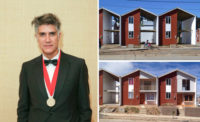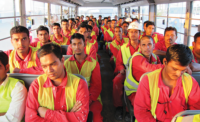You can’t take the hype out of the Hyperloop. In 2013, billionaire tech entrepreneur Elon Musk kicked off a 21st-century Space Race when he put forth an open-source vision for a transit system that could propel people and cargo at near supersonic speeds. Since then, Silicon Valley companies have been scrambling to be the first to unveil a viable prototype.
One start-up is breaking away from the pack. A Los Angeles–based company called Hyperloop One successfully shot a 1,500-pound aluminum sled down a 1,000-foot-long track in the Nevada desert this May, reaching 116 miles per hour in 1.1 seconds. (“I had tears mixed with sand,” the company’s cofounder, Shervin Pishevar, wrote in a blog post the next day.)
Hyperloop One is continuing to bet big on this emerging technology—in more ways than one. It’s working to establish routes in California, Russia (billed as a “new Silk Road”), the United Kingdom, Finland, and the United Arab Emirates. And, immediately following the Nevada test, it began working with starchitect Bjarke Ingels and his firm BIG on the design of the stations and the user experience.
On November 8, atop the Burj Khalifa, BIG and Hyperloop One unveiled renderings for gleaming stations along a route that would enable passengers to “hyperjump” the 90 miles between Abu Dhabi and Dubai in just 12 minutes.
BIG worked with Hyperloop One’s engineers to devise a design that would nearly eliminate waiting. As with Uber, users could request a pickup by a self-driving “Hyperpod” on their mobile phones. These pods—pictured in renderings as reflective, square-shaped vehicles that could accommodate between six and eight passengers—would glide to docks at a centrally located station or “Hyperportal,” where they would be inserted into a pressurized transporter capsule, elevated on skis. This levitating transporter will then glide through a low-pressure tube at nearly 700 miles per hour.
The designs for two of the proposed eight Hyperloop stations in the UAE are set at the base of the Etihad Towers in Abu Dhabi and the Burj Khalifa in Dubai, each a futuristic but elegant response to its context. The Abu Dhabi portal is a glazed, ring-shaped volume with a reflective roof. Meanwhile, the Dubai station at the base of the Burj Khalifa is a sunken, spiral-shaped volume. Inside the airy column- free interior, the pods are docked in circular terraces.
“We are heading for a future where our mental map of the city is completely reconfigured,” promised Ingels in a statement.
But there are still plenty of challenges ahead for Hyperloop One, including cost, navigating red tape, and a highly publicized lawsuit between the company and its former CTO. Some have also pointed out that the high-speed ride inside the tube could be a terrifying experience. (In an article, New York magazine pointed to one transportation blogger who predicted such a concept would amount to a “barf ride.”) But BIG plans to integrate openings in the low-pressure tube at even intervals, so that the landscape will flash by like a filmstrip, “a bit like waving your hand in front of your eyes,” the firm explains.
In the coming weeks, Hyperloop One will work with BIG, Dubai’s transit authority, and consultants from McKinsey & Company on a detailed technical study. Hyperloop One is hoping to achieve its “Kitty Hawk” moment—a test of a fully working prototype—early next year and aims to have constructed the world’s first Hyperloop by 2020.











Post a comment to this article
Report Abusive Comment